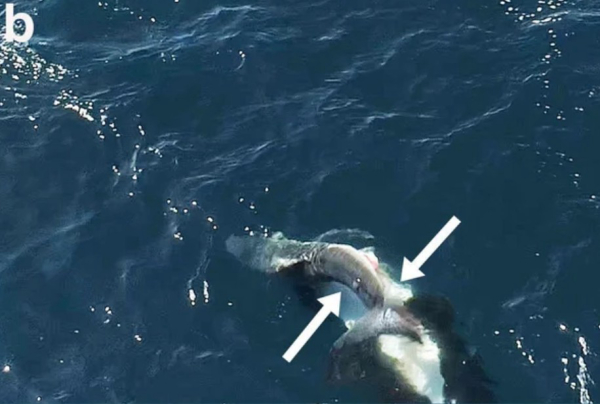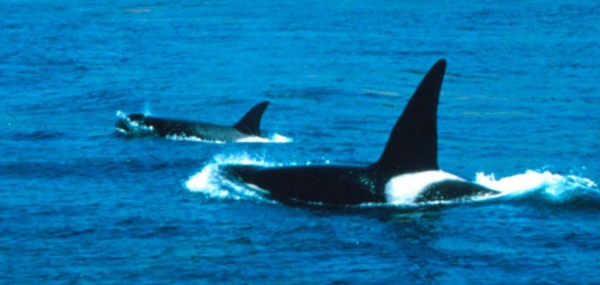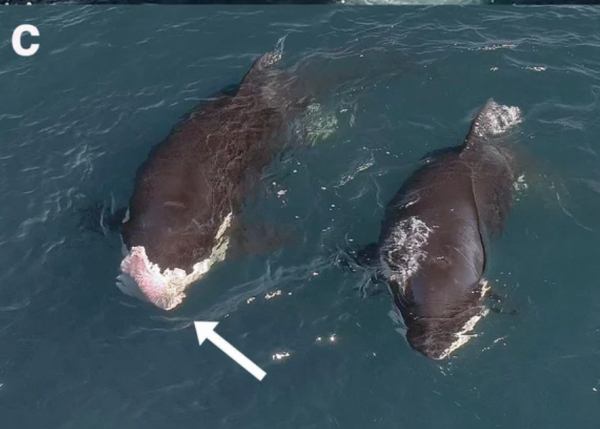
Cue the Jaws theme music.
Only this time, it’s Jaws that’s being hunted.
The baddest creature in the sea is not the great white shark, after all. It’s the ocean’s own Dr. Hannibal Lecter—a killer whale with a taste for shark liver tartare. While the victim is still twitching.
And now scientists have evidence that these black-and-white assassins aren’t just picking on grown-ups. They’re going after the kids, too.
For decades, great white sharks (Carcharodon carcharias) have swaggered through the sea with few natural enemies—just one, in fact. The killer whale (Orcinus orca) is the only predator that dares to flip the script on the ocean’s most famous hunter. Around the world, orcas have been caught in the act of ambushing and dismembering adult white sharks, delicately removing and dining on their massive, oil-rich livers. It’s apparently like foie gras for apex predators.
They were so efficient at it around False Bay, South Africa—once the set for every “shark breach” video ever made—that the great whites finally packed up and left—or were eaten. Scientists say the locals haven’t seen one there in years.
Now new research out of Mexico shows that orcas in the Gulf of California have graduated from shark-slayer to shark-day-care-raider. The study, published in Frontiers in Marine Science in 2025, reports the first confirmed cases of orcas hunting juvenile white sharks in Mexican waters—and only the second such observation so far.
Marine biologists observed and filmed two attacks—one in August 2020 and another in August 2022—off the Baja Peninsula. Each time, a pod of five or six killer whales ganged up on young great whites about six feet long. It wasn’t a fair fight. Think Mike Tyson versus your kid’s swim coach.
Once again, the orcas used classic teamwork. They flipped the sharks upside down to induce “tonic immobility”—a kind of biological Ctrl-Alt-Delete that makes sharks freeze up—and then used surgical precision to pop out the liver like it came with a pull tab. The rest of the shark was tossed aside, much to the delight of seabirds who arrived for the buffet.

The whole performance was caught in high-def from boats, drones, and underwater cameras. The whales’ technique mirrored that of their South African cousins, who’ve perfected the same trick. Evidently, word gets around in orca society.
Researchers believe this Baja pod is a highly specialized group that’s learned to target sharks and rays. In previous years, the same whales have been caught harassing bull sharks, whale sharks, and anything else shaped like a torpedo.
So why are the baby whites even there? Scientists say shifting ocean temperatures and a warming Pacific have redrawn the sharks’ nursery map. Juveniles that once stuck to cooler California waters are now wandering south around Baja—right into orca country. It’s the marine version of moving into a neighborhood without checking the crime rate.
Meanwhile, orcas are year-round residents in the Gulf of California. The overlap is producing a new kind of predator-prey drama: Baby Shark meets Silence of the Lambs.
In the 2020 attack, five female orcas—four teenagers and one adult—took turns flipping and dissecting two juvenile great whites. The liver was passed around the pod like a Thanksgiving side dish, while frigatebirds and pelicans dove for leftovers. Two years later, a different pod—including an adult male and a calf—repeated the performance, complete with sky-cam coverage.

Adult great whites, having seen this horror show before, usually get out of town when orcas show up—sometimes vanishing for months. But the juveniles, too young to recognize trouble when it whistles, stick around. That may be putting a dent in already slow-reproducing white shark populations.
Killer whales, of course, are famous for their dietary diversity. Some pods chase seals, some herd fish, others seem to prefer sharks and rays. Whether this newfound taste for white-shark pâté becomes a lasting menu item remains to be seen.
For now, scientists will keep monitoring the Gulf’s shark nursery—counting who grows up and who winds up as liver snacks for the ocean’s most charming psychopaths.
No word yet on whether the orcas prefer them with “fava beans and a nice Chianti,” as did Dr. Lecter.
— Frank Sargeant
Frankmako1@gmail.com
CORRECTION:
In last week’s column I indicated the zebra mussels and the round gobies that feed on them had reached all the way to the waters of Minnesota.
That was wrong.
While there are some zebra mussels there, no round gobies have made it thus far, and they assuredly don’t want any, as Brad Parsons, Fisheries Section Manager for the Minnesota Division of Fish and Wildlife, pointed out to me.
“It may well be the case that walleye are doing better on Lake Erie following the introduction of zebra mussels and gobies, but that lake is a special case where nutrient loading into that system means that the water still stays relatively turbid and productive”, Parsons said in an email. “Our less fertile Minnesota lakes become much less hospitable to walleye when zebra mussels arrive, and there is ample scientific evidence to support this. My staff work extremely hard to provide and protect excellent walleye fishing opportunities. The last thing we need is for people to ignore your, at best, lukewarm admonition at the end of the article and start moving gobies around to “fix” lakes with zebra mussels.”
He is, of course, exactly right, and I apologize for implying anything else. It’s a rare accident when an invasive species brings good results, on land or in the water, and no conscientious angler would ever want to be guilty of transporting any of these unwanted critters to new locales—to say nothing of the considerable legal penalties for doing so.
F.S.